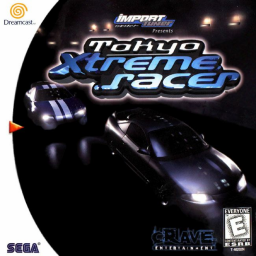I am writing this based mostly on my own research. This section of the guide discusses how to choose a car, their upgrades, and their settings. Finally, it discusses driving physics. For more detailed information and an upgrade calculator, view my forum post or the Speedrunning Spreadsheet in Resources.
Car Stats, Upgrades, and Settings
It is impossible to see vehicle stats and how well they will upgrade without purchasing it; but, once purchased, the stats can be viewed in the upgrade screen or garage by pressing a trigger. The only really important stats are power, weight, and gearing. (Gearing can be viewed in the vehicle Settings screen.) Power obviously makes the car faster; gearing can limit a car's top speed. Weight has several effects: Lighter cars accelerate faster (and I believe they also brake and turn a little harder), lighter cars are more responsive, heavier cars are more stable, and heavier cars have an easier time pushing rivals (into the walls and such).
(Remember that when you sell a car, any money put into upgrades is lost! Be careful to not spend more than necessary upgrading a car you plan to sell later.)
Primary Upgrades
Engine: Engine upgrades are easily the most important. Each stage increases horsepower by about 20% of the base horsepower, depending on the car. So stage 5 roughly doubles horsepower. Suspension: Suspension Stage 3 unlocks all the suspension settings, which can be helpful for unstable cars. Stage 4 appears to do nothing but decrease the weight by 2 kg, which is not even worth the menuing. Drive Train: I have not investigated how much benefit Stage 1 gives. Stage 2 and 3 are needed if your car is geared too low. Stage 4 appears to do nothing but decrease the weight by 2 kg, which is not worth the menuing. Chasis: Each chasis stage decreases weight by 25 kg (except for the P930, for which each stage reduces weight by 50, 25, 25, and 75 kg respectively).
Secondary Upgrades
Muffler: A muffler increases power by about 10 HP. For any given car, all mufflers have the same power bonus, but the more expensive ones also decrease weight by 1 or 2 kg, depending on price. I never buy the lighter mufflers because of cost and menuing time. Each wheel and aero upgrade also decreases weight slightly, usually by 1 to 3 kg each, but the menuing is slow, so it is probably not worth doing.
Car Settings
Steering Speed and Brake Response can be adjusted without purchasing upgrades, and I always do so. I will make the other settings only if I buy the necessary upgrades, which I often do not. I recommend the following settings:
- Steering Speed: Max. The car will both turn faster and be easier to control.
- Brake Response: Max.
- Brake Balance: I use full front, but this is mostly preference.
- Clearence: Minimum.
- Shocks and Damping: Max.
- Transmission Ratio and Final Gear: For a late game car, your displayed max speed should ideally be between 220 and 240 mph.
Car Selection
There are 35 playable cars in the game, of which 33 are playable. (The AE86TD requires a cheat code and the Japanese version of the game, and the NA2D (Banshee's car) is not playable.) Only a few cars are useful during the run, and I discuss all of them here.
Your First Car
Seven affordable cars are available from the start. The two best of which are the S13 and the EK9. The S14 has performance almost identical to the S13, but costs 5,000 CP more. The RPS13 is both more expensive and heavier than the S13, while being otherwise identical. Similarly, the DC2 is almost identical to the EK9, but costs 5,000 CP more. The AE86L and AE86T are functionally identical to each other; both of which are uselessly slow without a drive train stage 3 upgrade to raise the gearing, and that added cost makes these cars useless in a run. The S13 and EK9 are so close in performance that choosing one is mostly a matter of preference. The S13 is more powerful, has higher gears, and overall slightly faster. The EK9 is lighter, easier to control, and has cheaper upgrades. The lower gearing of the EK9 will become problematic if you upgrade the engine past stage 2 or 3, so I do not recommend the EK9 if you plan to fully upgrade the car. Whichever of these two cars you choose, you should also immediately buy a Stage 1 Engine upgrade and the cheapest Muffler, which you can do with your starting cash.
Your Second Car
Once you have enough money, you can buy a faster car. After buying one, remember to sell your old car for cash! Also note that whenever there are two versions of the same car and one was unlocked from a Deva or Devil, then the Deva/Devil version will upgrade better (usually about 50 HP extra).
Several cars are potentially useful:
- R32: The R32 has high horsepower, is easy to control, and is geared high enough to never require drive train upgrades. Some other cars on this list can also make a good second car, but they are difficult to justify. Stock: 276 HP/1500 kg, Upgraded: 529 HP/1410 kg.
- R33: By a small margin, the most powerful car in the game that does not require an unlock. The meaningful differences compared to the R32 are the slightly increased power, slightly increased weight, and slightly increased price. Stock: 276 HP/1540 kg, Upgraded: 538 HP/1450 kg.
- FD: Very high power/weight ratio. Its weakness is the low stock gearing, which will require Drive Train Stage 3 to fix. The very low weight makes the FD pretty squirly, so do not use if you are not confident with car control. Stock: 276 HP/1280 kg, Upgraded: 506 HP/1190 kg.
- FDD: (unlocked after Midnight Cinderella) Second highest power/weight ratio in the game (after the S30). In all other ways, it is the same as the FD. This car might be worth taking if you manage to unlock it before purchasing your second car. Stock: 276 HP/1280 kg, Upgraded: 555 HP/1190 kg.
- GC8: This car has very limited usefulness. It has the highest power/weight ratio of any car available from the start, but its gearing is horrible. With Drive Train Stage 3, you can mostly fix the problem, but it will still struggle to top 175 mph. Stock: 276 HP/1240 kg, Upgraded: 506 HP/1150 kg.
Your Third Car
Any of the cars above (except maybe the GC8) are fast enough to beat the game with varying amounts of required skill, but upgrading to one of the following cars will make it easier to beat the final devils and Iceman:
- R34D: (unlocked after Red Devil) Second most powerful upgraded car in the game (after the S30). It is also geared high enough to not require Drive Train upgrades. For Beat All Racers runs, you should generally try to get this car as soon as possible. 230,000 CP, plus the sale of your second car, will give you enough money to fully upgrade the Engine and Chasis, and get Suspension Stage 3 and Drive Train Stage 1. Stock: 276 HP/1560 kg, Upgraded: 646 HP/1470 kg.
- P930: (unlocked after ZERO) Very high power/weight ratio and easier to control than the FDD. At moderate speeds it accelerates faster than any other car (except the S30). However, because it is unlocked so late in the run, this car is only useful if you're struggling to beat Iceman or ???, but I still do not recommend purchasing it. Do not purchase unless you have at least 410,000 CP. Stock: 354 HP/1470 kg, Upgraded: 599 HP/1305 kg.
Useless Cars
Although none of these cars are useful in a run, you may want to know about them nevertheless. The most powerful car in the game is the S30 (???'s car), which can be unlocked by beating all 100 racers in Quick Race mode. When fully upgraded it has 724 HP and weighs only 946 kg. It cannot be used in a run because you cannot start a run with any cars previously unlocked. Although the car is cheap, it is extremely slow when stock (second only to the AE86s), has very expensive upgrades, and only becomes easy to control after upgrading the suspension. It is also the only car in the game for which the gearing is raised with each engine upgrade, which is very necessary given its low initial gearing. The NA2 upgrades to a max 492 HP and has 6 gears, but the car is both very expensive to purchase and does not outperform other options. The JZA80 and JZA80D upgrade to 515 and 554 HP, respectively, which is almost identical to the FD and FDD. They also have 6 gears. Unfortunately, they weigh 240 kg more than the FD/FDD, which makes them more stable, but slower. The S15 and AP1 are disappointingly slow when upgraded, despite requiring an unlock to purchase.
Driving Physics
FACT: The physics in this game are...unique. (But I love them anyway.) I have a few recommendations for improving your driving.
- Avoid rear-ending traffic at almost all costs. Braking down to a very low speed is better than hitting them.
- Bouncing off walls is clearly necessary, but for moderate turns it can often be faster to brake a little if it means can can avoid hitting.
- Bouncing off walls is risky, especially near other cars or when defending the lead.
- Against difficult opponents, slowing and hugging the inside of the turn might be better than bouncing off the outside, especially near traffic. It can mess with the AI path-finding in weird ways.
- Using the brakes is the fastest way to rotate your car. Use them when entering or transitioning between turns, or to evade traffic. You should usually not let off the gas when you do this because...
- The throttle-brake interaction in this game is not at all realistic. Braking reduces your speed and encourages your car to rotate. Throttle applies a force to push the car in the direction it is POINTED (this effect is even more pronounced with 4WD cars). The crazy thing is that you can get both benefits simultaneously. In other words, if you gas and brake together while turning, the car will both slow down/rotate more AND be pushed in the direction the vehicle is pointed. Therefore, the car is most agile when both gas and brake are used.




